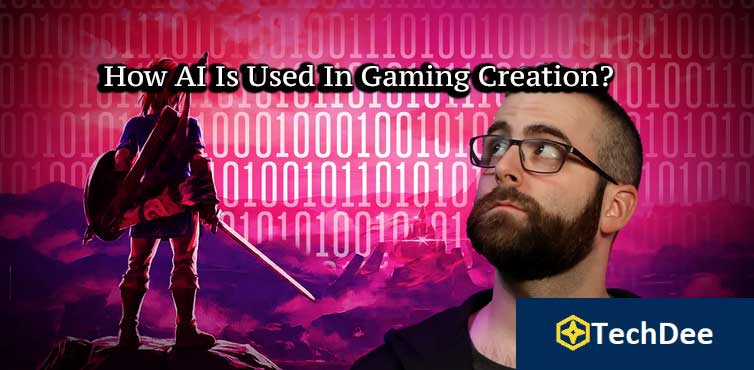Everyone knows about Pong. A simple two-dimensional game replicating table tennis, it was released in 1972 and became the first commercially successful video game. The concept was simple – hitting a ball back and forth across a screen – but it was an instant hit. People could play with friends or in a single-player mode. How? Well, it was thanks to AI in gaming creation.
AI and video games have always been inextricably linked. In fact, Alan Turing, one of the technology’s founding fathers and renowned World War II cryptanalyst, developed a chess-playing algorithm before computers even existed to run it.
The main objective of AI in gaming creation is to build a world that players can immerse themselves in and to provide the best responses to specific stimuli. In Pong, that was getting the paddle to block your shots. In
How to use AI in gaming creation
Video game creation is a lengthy process. Super Mario 64 and Grand Theft Auto V both took three years to make, while Cyberpunk 2077 took about nine years. This makes production expensive – staff, technology, and expertise all come at a price. So how can this process be sped up? Simple: with AI.
Character creation
No video game is complete without characters, but they’re notoriously tricky to create. Their detailed facial expressions, voices, and emotions take hours upon hours of intricate work.
To speed up the process, developers have begun using automated real-time deep learning to design 3D characters. There have also been advancements in motion simulation thanks to a research team from the University of Edinburgh and Method Studios. A machine learning system is given motion capture clips, and it then makes an animated character that can run, jump, and navigate obstacles.
Ubisoft has come up with its own method of character animation by using neural networks. This has led to accurate animations that change depending on player controls and scenes.
Making worlds and levels
Procedural content generation (PCG) isn’t limited to characters; it also includes the worlds that games take place in. Using AI, developers can create new levels for games that already exist – like computer scientists at Politecnico di Milano have done with DOOM – or even entirely new games from machine learning.
This also comes in handy with endless map creation. In games like No Man’s Sky, machine learning algorithms generate more locations while the player is exploring. It literally creates an infinite universe.
Plotting routes
It’s all very well having the characters and the worlds, but if the two can’t connect, then what’s the point? To fix this, developers are using AI for pathfinding – finding the shortest route between two points. It’s now much easier to move characters of different shapes and sizes, whether the player or non-playable characters (NPCs), across maps and around obstacles.
According to Julian Togelius, an associate professor at New York University’s department of computer science and engineer, pathfinding is one of the core components of commercial game AI.
Object detection
When you’re playing a game, you want to interact with your surroundings. So how does AI help in this bit of gaming creation? One way is an advanced technology known as TensorFlow. An end-to-end, open-source machine learning platform, it understands and makes practical use of real-life experience.
Analytics
But what happens after the game is released? What if there’s a bug or an error that could cost your company precious revenue? This is where game analytics comes in.
AI in gaming creation isn’t limited to production; it can also quickly uncover problems and deploy appropriate fixes before there’s any real impact on the game.
The problem with AI in gaming creation
There’s no doubting the benefits of AI in gaming creation, but what about the downsides? First and foremost is the ability of the games to be played. As they become more sophisticated with machine learning algorithms, computers and memory are struggling to keep up.
This isn’t just a problem with desktops, though. Mobile devices and smartphones also have limitations.
Getting the balance just right between concept and playability is more important than ever when trialing new AI and machine learning creation methods.
But the video game industry isn’t using the most recent, cutting-edge AI technology in gaming creation. Why? Because games would be unplayable. Machine learning would make unpredictable storylines and be unable to tell a compelling narrative with a satisfying ending.
As a result, the AI used in games is sophisticated, but only to a point – it’s still controlled and predictable. As Togelius points out: “Typically when you design the game, you want to design an experience for the player. You want to know what the player will experience when he gets to that point in the game. And for that, if you’re going to put an AI there, you want the AI to be predictable.”
Can AI improve Old Games?
Perhaps one of the most exciting advancements in AI for gamers over the past couple of years, machine learning is now being used to improve the graphics of older games. Known as AI upscaling, it takes low-resolution images and generates versions with more pixels
It’s not as simple as it sounds, though. It takes hundreds of hours of human work, even with the help of machine learning and AI.
So many older games have received the upscaling treatment, like DOOM, Half-Life 2, Final Fantasy VII, and even Mass Effect 2.
The Future of AI in Gaming Creation
Games and AI aren’t going to stop evolving – at least not any time soon. The two are becoming ever-more entwined, and it looks like we’re going to enter into a collaborative relationship with AI. While this could lead to smaller teams and bigger games, it also means that there’s room for evolution. One day we could truly capture the complexity of the real world.
Follow TechDee for more Tech News and Updates
